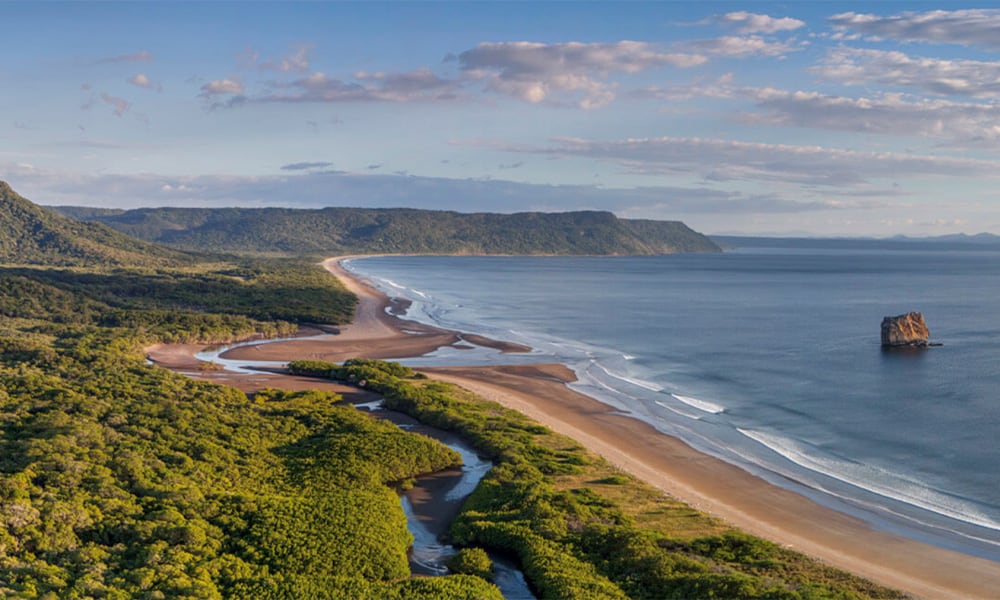Santa Rosa National Park beckons with brain food for history buffs, campsites for backcountry nature lovers and magnificent, out-of-the-way waves for adventurous surfers. Well off Costa Rica’s beaten tourist path, in the northwestern corner of the country, Santa Rosa offers a potholed adventure where iguanas skirmish across the dry forest floor and where U.S. filibuster William Walker’s legacy is preserved in an old dusty ranch.
It’s also home to world-class surfing destination Witch’s Rock, where mighty offshore winds sweeping in from across nearby Lake Nicaragua clash with cavernous tubes of water in a splashy spectacle that will leave the surliest surfer with a smirk.
No matter where you’re coming from, be it Liberia, San José or the Nicaraguan border, Santa Rosa is a bit of a drive. And once you’re inside, it’s guaranteed to be a pothole-ridden expedition, albeit beneath blue Guanacaste skies.
Some of the roads in the national park, particularly the 13-kilometer stretch to Witch’s Rock, define “rugged,” and may be the rocky road adventure you’re looking for.
The beach at Witch’s Rock is desolate, desert-like. Powerful winds sweep sand across the beach’s surface like snow creeps across a windswept highway in the depths of a northern winter.
The wind is unbearable. It’s hard to stand up in, and it will snatch your surfboard right from beneath your armpit if you’re not sturdy. But all this makes for surfing perfection.
The wind pushing against the breaking waves seems to suck the power out of what appear, to the untrained eye, to be hulking waves. Their faces disintegrate into thin air, creating a spray that shoots back behind the wave for meters and meters. What start out as seemingly destructive walls of water are whittled away by wind in what seems like slow motion.
The rock is about a 15-minute walk from the beach campsite, where a few surfers slung in hammocks pat on bongo drums and strum guitars.
Getting there, from the park entrance, will require an exhausting two-hour drive that demands a four-wheel-drive vehicle and a prostate gland that is not already swollen. It’s a grueling trip, though well worth it. Making the round trip in one day is particularly tiring.
More accessible is La Casona, as it’s known, where mercenaries of the aspiring U.S. colonizer William Walker ran into Costa Rican forces in a short-lived but legendary skirmish known as the Battle of Santa Rosa in 1846.
Walker’s men had somehow managed to take over the colonial hacienda, and when Costa Rica got word, troops were sent to defend its territory just a few kilometers from the Nicaraguan border.
It was the battle that made a national hero of Juan Santamaría, the drummer boy who was shot as he attempted to set the ranch home ablaze with Walker’s men inside.
For a peaceful country with what some consider an uneventful history compared to the dramatic pasts of its neighbors, La Casona is a reminder that even the “Switzerland of Central America” has had to fight its fights.
“He who invades Costa Rica with distorted intentions doesn’t get past Santa Rosa,” reads a quote by former President Francisco Orlich on a plaque outside the villa.
The home is being renovated with new floors and patchwork on the walls, says renovation project director Alfonso Faerron. It’s the first renovation the historical site has undergone since 2000, when a hunter, angered by the ban on hunting in the national park, set the place ablaze and damaged as much as 80% of the home.
Getting to Santa Rosa National Park
From Liberia, Santa Rosa is about two hours to the north, off a tiny road on the left-hand side, about 35 kilometers before La Cruz. It’s best to come with a car, as it is several kilometers from the park entrance to La Casona and Witch’s Rock.
Park guards say no more than 20 people make it to Witch’s Rock a day, though surf tour guides from the Guanacaste tourist destinations of Playas del Coco and Tamarindo bring in surfers almost daily to the surf spot.






